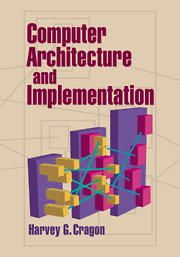4 - MEMORY SYSTEMS
Published online by Cambridge University Press: 05 June 2012
Summary
INTRODUCTION
Chapter 1 described a computer as a memory-centered system. The process state is stored in memory, then the state is modified by the processor and returned to memory. Because of the importance of memory, we first consider its architectural and implementation aspects before addressing processor design in Chapters 5 and 6. Chapter 3 discussed data types, and the point is made that data types vary in length: 1 byte, 2 bytes, etc. In this chapter the addressable unit (AU) will be the normalizing factor in discussing memory designs. For processors such as the Intel x86 and the IBM S360, the AU is a byte. For other processors, the AU may be 2 or 4 bytes.
Process State
A process is defined as a program in execution. A program is defined as a series of instructions that process data and is contained within the process state. Thus the process state consists of the program, source data, and results. Execution of the program results in the transformation of data; the memory must supply instructions and data and accept the results.
It follows then that the memory must be large enough to hold the process state, and the memory can be a limiting factor in the performance of a computer. On an instruction-by-instruction basis, the process state is modified. In some software systems, MSDOS and Windows 3.1 being examples, the instructions can be treated as data and modified by the program, called self-modifying code and discussed in Chapter 1 in the context of the von Neumann programming example.
- Type
- Chapter
- Information
- Computer Architecture and Implementation , pp. 131 - 182Publisher: Cambridge University PressPrint publication year: 2000

